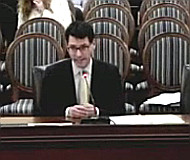Article from: www.thenewspaper.com/news/63/6398.asp
2/13/2018
Maryland Officials Admit Longer Yellows Reduce Violations
Legislation in Maryland would force cities to give motorists at least 4 seconds of yellow time at photo enforced intersections.
 The Maryland General Assembly's legislative analysts believe a proposal to lengthen yellow signal timing at red light camera intersections could cost local jurisdictions a lot of money. The non-partisan researchers are tasked with making a cost estimate of newly introduced bills, such as Delegate Marc Korman's (D-Montgomery County) measure to establish a minimum yellow time of 4.0 seconds at red light camera intersections.
The Maryland General Assembly's legislative analysts believe a proposal to lengthen yellow signal timing at red light camera intersections could cost local jurisdictions a lot of money. The non-partisan researchers are tasked with making a cost estimate of newly introduced bills, such as Delegate Marc Korman's (D-Montgomery County) measure to establish a minimum yellow time of 4.0 seconds at red light camera intersections.
"Because the bill potentially results in longer yellow lights in some jurisdictions, local revenues decrease, potentially significantly, beginning in fiscal 2019, as fewer individuals may be recorded entering an intersection against a red light signal," the legislative analysis explained.
This was exactly what happened in Ohio and Georgia, the two states that have enacted laws requiring yellow times last at least 4.0 seconds at photo enforced locations. In Georgia, red light running decreased 70 to 80 percent on the day the law took effect. Likewise in Ohio, red light violations plunged as drivers had more time to get through intersections safely. In a hearing last week, Korman explained that he modeled his proposal on Maryland's speed camera law, which gives drivers a 12 MPH leeway before automated tickets can be issued.
"This bill's agnostic on whether or not you have these cameras," Korman explained. "My proposition is that if you're going to have the cameras, they should be following the rules."
Korman described the effect of longer yellows in Montgomery County, where the timing at a number of locations increased after an inspector general report exposed short-timed intersections (view report). Korman held up a chart showing a massive reduction in red light running following the half-second addition to the signal timing (view chart).
"This actually makes a difference to our constituents in that these [cameras] are used for revenue," Korman said. "I'm sure there's testimony in your packet that may not reference revenue, but I'm sure you know why they put it in."
This reference was to the Maryland Association of Counties (MACo), a lobbying group representing the jurisdictions that issue photo citations. In a written statement to committee members, the group argued for keeping the current system's flexibility that allows signal times to be as short a 3.5 seconds.
The Maryland Drivers Alliance, by contrast, endorsed the effort to lengthen yellow times. Ron Ely, the group's leader, told the committee that new data show red light running decreased 67 percent in the left-hand lane of Georgia Avenue at Seminary Road after the timing was increased from 3 seconds to 3.5 seconds.
"This will improve safety," Ely told the committee. "Study after study have shown longer yellows reduce the rate of red light running, and that should be something we all strive for."
A fraction of a second difference in yellow time can have a significant influence on the number of red light camera citations issued. The majority of straight-through red light "violations" happen when a driver misjudges the end of the yellow light by less than 0.25 seconds -- literally the blink of an eye (view Texas Transportation Institute (TTI) chart). In most cases, a yellow shortened by one second can increase the number of tickets issued by 110 percent, according to TTI (view report).
A copy of the bill is available in an 80k PDF file at the source link below.
Source: House Bill 204 (Maryland General Assembly, 2/8/2018)
Permanent Link for this item
Return to Front Page
 The Maryland General Assembly's legislative analysts believe a proposal to lengthen yellow signal timing at red light camera intersections could cost local jurisdictions a lot of money. The non-partisan researchers are tasked with making a cost estimate of newly introduced bills, such as Delegate Marc Korman's (D-Montgomery County) measure to establish a minimum yellow time of 4.0 seconds at red light camera intersections.
The Maryland General Assembly's legislative analysts believe a proposal to lengthen yellow signal timing at red light camera intersections could cost local jurisdictions a lot of money. The non-partisan researchers are tasked with making a cost estimate of newly introduced bills, such as Delegate Marc Korman's (D-Montgomery County) measure to establish a minimum yellow time of 4.0 seconds at red light camera intersections.